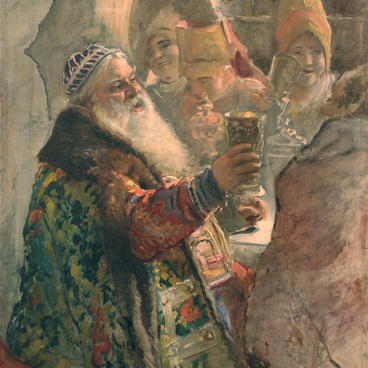The icon Nativity of the Blessed Virgin Mary is dedicated to one of the Twelve Great Feasts, the most important Orthodox Holidays. The event is described in the apocryphal Protoevangelium of St. James dated back to 2nd-3rd centuries. This is an unbiblical and non-canonic text; however, it does not contradict to Christian books.
Nativity of the Blessed Virgin Mary
Время создания
16th century
Размер
58x38,5 cm
58х38.5х2 cm
58х38.5х2 cm
Техника
Wood, tempera
2
Открыть в приложении#1

Unknown author
Nativity of the Blessed Virgin Mary
#2
#4
According to the Protoevangelium, Virgin Mary’s parents were Holy Joachim and Venerable Anna from the lineage of King David. For a long time, they had had no children, and when Anna was at the advanced age, an angel appeared in front of her in the garden and annunciated that she would soon give birth to the Virgin Mary, the Holy Mother of the Savior.
The most ancient image of the Nativity of Virgin Mary dates back to the 11th century. That fresco is located in a Roman church that was consecrated in the name of St. Mary of Egypt. Two centuries later, a canonic composition of the icon was established: the icon is supposed to consist of 4 subjects: Nativity, baptismal immersion, fondling of Mary, and Joachim watching the Nativity.
#5
In Russia, one of the first to paint the Nativity of the Blessed Virgin Mary was the Russian icon painter Dionysius when he worked at frescos in the St. Therapontus Monastery. The same subject can be seen in pre-Mongolian murals in the Cathedral of Transfiguration of the Mirozh Monastery.
#6
The icon
#7
The icon that is now kept in the collection of the State Museum of Fine Arts of Khanty-Mansiysk was painted in Rostov in the 16th century. The figure of Venerable Anna on the bed is in the center of the composition. On the right side there are Anna and Joachim fondling the baby, bottom left is the baptismal immersion episode. Some buildings are depicted in the background, and the face of Joachim can be seen in one of the windows.
The icon base is a panel cut from heartwood; a special cut-back center portion of the icon panel (called ‘the artophorion’) was carved out to protect images of the Saints from damage. The panel was coated with a primer: a chalk solution with oil and glue, which made the coating strong.
#8
Icons were painted with tempera: a special paint based on powdered pigments. They were dissolved in raw egg yolk, therefore, when dry, the coating acquired glossy shine. The halos of the Saints were coated with a thin layer of leaf gold.
#9
The Nativity of the Blessed Virgin Mary was acquired by the Generations Fund of the Khanty-Mansi Autonomous District in 2002 from the Antique Dealer Association ‘The islands of St. Petersburg’. Eight years later, the work was transferred to the State Museum of Fine Arts of Khanty-Mansiysk collection.
#10
State Museum of Fine Arts of Khanty-Mansiysk
читать дальшескрыть
00:00
00:00
1x
Nativity of the Blessed Virgin Mary
Время создания
16th century
Размер
58x38,5 cm
58х38.5х2 cm
58х38.5х2 cm
Техника
Wood, tempera
2
Открыть в приложении
Поделиться
